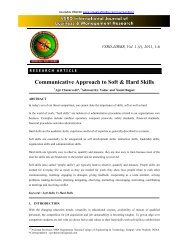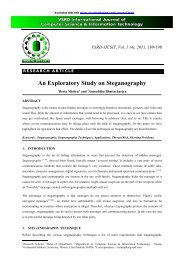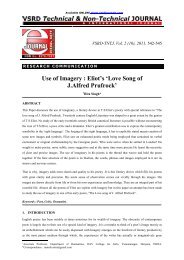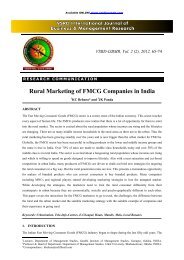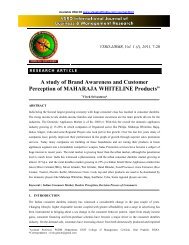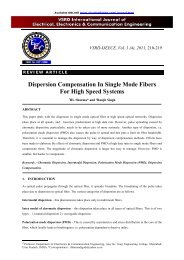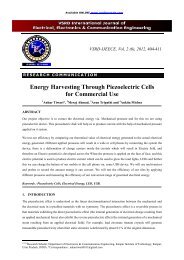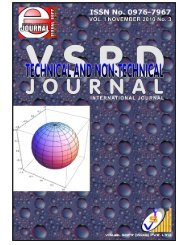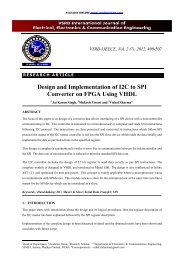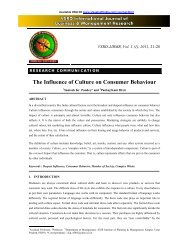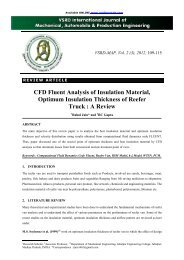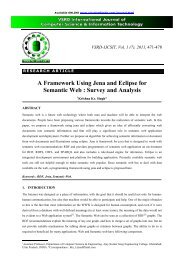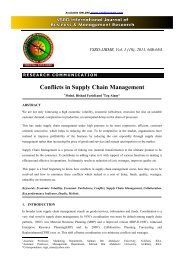Download Complete Article in PDF Format - vsrd international ...
Download Complete Article in PDF Format - vsrd international ...
Download Complete Article in PDF Format - vsrd international ...
Create successful ePaper yourself
Turn your PDF publications into a flip-book with our unique Google optimized e-Paper software.
Available ONLINE www.visualsoft<strong>in</strong>dia.com/<strong>vsrd</strong>/<strong>vsrd</strong><strong>in</strong>dex.html<br />
R E S E A R C H C O M M U N II C A T II O N<br />
ABSTRACT<br />
____________________________<br />
VSRD-TNTJ, Vol. 2 (5), 2011, 238-248<br />
Biodegradation of Textile Dyes<br />
By Pseudomonas Species and E.Coli<br />
1 Tom S<strong>in</strong>oy E.S.*, 2 Dhade Anuradha Mohan and 3 Humera Shaikh<br />
In the present study, an attempt was made to exam<strong>in</strong>e the potential of aerobic mixed culture for decolourization<br />
of Brilliant green Malachite green, carbol fuchs<strong>in</strong> and crystal violet dyes. The effect of pH, temperature,<br />
<strong>in</strong>oculums and <strong>in</strong>itial concentration of dye was studied with an aim to determ<strong>in</strong>e the optimal conditions required<br />
for maximum decolourization and degradation. The culture exhibited maximum decolourization ability at pH<br />
between7-8 and at 30°C.10% (v/v) <strong>in</strong>oculums were found to be the optimum for decolourization. A maximum<br />
of 98% decolourization was observed at 25 ppm <strong>in</strong>itial concentration of dye after 18 hours of <strong>in</strong>cubation period.<br />
At higher dye concentration of 300 ppm, the removal of color was found to be 75% <strong>in</strong> 48 hours of <strong>in</strong>cubation<br />
period. The results show that the enriched mixed culture from activated sludge has good potential <strong>in</strong> removal of<br />
Brilliant green and crystal violet dyes from wastewater under aerobic conditions.<br />
Keywords : Decolourization, Brilliant Green, Malachite Green, Carbol Fuchs<strong>in</strong> and Crystal Violet, Aerobic<br />
Conditions.<br />
1. INTRODUCTION<br />
Synthetic dyes are color<strong>in</strong>g agents ma<strong>in</strong>ly used <strong>in</strong> textile <strong>in</strong>dustries which generate a huge amount of wastewater<br />
<strong>in</strong> the process of dye<strong>in</strong>g. It is estimated that these <strong>in</strong>dustries discharge around 280,000 tonnes of dyes worldwide<br />
every year <strong>in</strong>to the environment. A very small amount of dye <strong>in</strong> water (10-50 mg L-1) affects the aesthetic<br />
value, transparency of water and gas solubility of water bodies. The effluents from these <strong>in</strong>dustries are complex;<br />
conta<strong>in</strong> a wide variety of dyes and other products such as dispersants, acids, bases, salts, detergents, humectants,<br />
oxidants, etc. Discharge of these colored effluents <strong>in</strong>to rivers and lakes results <strong>in</strong>to reduced dissolved oxygen<br />
concentration, thus creat<strong>in</strong>g anoxic conditions that are lethal to resident organisms.<br />
Many reports <strong>in</strong>dicate that textile dyes and effluents have toxic effect on the germ<strong>in</strong>ation rates and biomass<br />
concentration of several plant species which play many important ecological functions such as provid<strong>in</strong>g the<br />
13 Assistant Professor, 2 Research Scholar, 123 Department of Biotechnology, Yeshwant College of IT (Bi-I<strong>in</strong>formatics & Bio-<br />
Technology), Nagpur, Maharashtra, INDIA.<br />
*Correspondence : biolichen@gmail.com
Tom S<strong>in</strong>oy et. al / VSRD Technical & Non-Technical Journal Vol. 2 (5), 2011<br />
habitat for wildlife; protect<strong>in</strong>g soil from erosion and provid<strong>in</strong>g bulk of organic matter that is significant to soil<br />
fertility.<br />
The toxicity of effluent is because of the presence of dye or its degraded products which are mutagenic or<br />
carc<strong>in</strong>ogenic. Therefore, the treatment of <strong>in</strong>dustrial effluents contam<strong>in</strong>ated with dye becomes necessary prior to<br />
their f<strong>in</strong>al discharge to the environment. Various k<strong>in</strong>ds of physico-chemical methods are <strong>in</strong> use for the treatment<br />
of wastewater contam<strong>in</strong>ated with dye. These methods are not environment friendly and cost-effective and hence<br />
become commercially unattractive.<br />
Many microorganisms belong<strong>in</strong>g to the different taxonomic groups of bacteria, fungi, act<strong>in</strong>omycetes and algae<br />
have been reported for their ability to decolorize azo dyes. However, ma<strong>in</strong>ta<strong>in</strong><strong>in</strong>g the purity of s<strong>in</strong>gle cultures <strong>in</strong><br />
the large scale application and their <strong>in</strong>ability to degrade all different dyes present <strong>in</strong> the actual effluent are the<br />
more potential for large scale application at field level. The syntrophic <strong>in</strong>teractions present <strong>in</strong> the mixed<br />
communities lead to complete m<strong>in</strong>eralization of azo dyes. In the present study, an attempt has been made for the<br />
degradation and decolourization of an azo dye us<strong>in</strong>g aerobic mixed culture <strong>in</strong> flasks. Effect of various process<br />
parameters like pH, temperature, <strong>in</strong>oculums concentration and <strong>in</strong>itial concentration of dye was studied.<br />
2. MATERIALS AND METHODS<br />
2.1. Location of Soil Sample And Source of Inoculums<br />
Soil sample collected from a small dy<strong>in</strong>g <strong>in</strong>dustry from where the colored effluent passes was used as the<br />
parent source of <strong>in</strong>oculums <strong>in</strong> the present study.<br />
2.2. Enrichment<br />
For enrichment of the culture, the heterogenous population was first grown aerobically <strong>in</strong> a medium conta<strong>in</strong><strong>in</strong>g<br />
1% (w/v) glucose (COD= 1100 - 1250mg/L) as the carbon and energy source. Dur<strong>in</strong>g acclimatization period,<br />
the amount of glucose was regularly checked and ma<strong>in</strong>ta<strong>in</strong>ed at 1%.<br />
The culture was gradually exposed to <strong>in</strong>creas<strong>in</strong>g concentrations of Brilliant green, crystal violet, Carbol Fuchs<strong>in</strong><br />
and malachite green dyes <strong>in</strong> order to acclimatize the microbial culture. Successive transfers of culture <strong>in</strong>to<br />
sterile nutrient broth conta<strong>in</strong><strong>in</strong>g higher concentrations of Brilliant green and crystal violet dyes upto 300 ppm<br />
was done at 37°C <strong>in</strong> rotary condition. This acclimatized microbial culture was for all experiments.<br />
2.3. Isolation and Screen<strong>in</strong>g of Dye Decoloriz<strong>in</strong>g Microorganism<br />
The collected soil samples were used for screen<strong>in</strong>g of dye decoloriz<strong>in</strong>g cultures by enrichment technique us<strong>in</strong>g<br />
nutrient broth amended with dye as a sole source of carbon and energy. Dye conta<strong>in</strong><strong>in</strong>g media (100ml) <strong>in</strong> 250ml<br />
Erlenmeyer flasks were <strong>in</strong>oculated with 10ml soil suspension (10%w/v) and <strong>in</strong>cubated <strong>in</strong> orbital shaker under<br />
static condition (150rpm). After 48 hours of <strong>in</strong>cubation, 1.0ml of the culture broth was appropriately diluted and<br />
plated on nutrient agar conta<strong>in</strong><strong>in</strong>g 100mg/l Brilliant green and crystal violet dye. After <strong>in</strong>cubation<br />
morphologically dist<strong>in</strong>ct bacterial isolates show<strong>in</strong>g clear zone around their colonies due to the decolourization<br />
of dye.<br />
Page 239 of 248
2.4. Identification<br />
Tom S<strong>in</strong>oy et. al / VSRD Technical & Non-Technical Journal Vol. 2 (5), 2011<br />
A pure colony of the unknown isolates were named as B1 and B2, these isolates were identified presumptively<br />
on the basis of the follow<strong>in</strong>g features gram sta<strong>in</strong><strong>in</strong>g, motility and biochemical reaction.<br />
2.5. Dye Decolourisation Studies<br />
Frequently used dyes were collected from dye house <strong>in</strong>dustry and one color was selected for better<br />
decolurization study us<strong>in</strong>g isolated bacterial organism.<br />
2.6. Inoculation of Bacterial Biomass<br />
The identified organisms B1 and B2 were grown <strong>in</strong> nutrient broth. About 5% (V/V) of 18 hour old culture was<br />
added for decolurization studies.<br />
2.7. Decolourisation Experiment<br />
The MSM medium constitutions amended with 100ppm of Brilliant green and crystal violet was <strong>in</strong>oculated with<br />
bacterial culture (5% v/v) and <strong>in</strong>cubated at 37°C under static condition. Samples were withdrawn at a particular<br />
<strong>in</strong>terval time (not exceed 7days) and analyzed for Decolorization.<br />
2.8. Analysis of Decolourisation Rate<br />
The decolourisation rate was monitored spectrometrically. The absorbance was monitored at 510nm for Brilliant<br />
green, 470nm for malachite green, 570nm for crystal violet and 520 for carbol fuchs<strong>in</strong> dyes. After <strong>in</strong>cubation<br />
5ml culture was taken from flask and centrifuged us<strong>in</strong>g bench top centrifuge (5000rpm for 20 m<strong>in</strong>utes) and the<br />
mean value was taken. Medium without dye and <strong>in</strong>oculums was used as blank. Medium with dye but without<br />
<strong>in</strong>oculums was used as control. The Decolorization efficiency was expressed as per the follow<strong>in</strong>g equation or<br />
formula.<br />
Decolorization % = I – F × 100 I<br />
Where, I: <strong>in</strong>itial absorbance: F: f<strong>in</strong>al absorbance<br />
2.9. Th<strong>in</strong> Layer Chromatography<br />
Confirmation of dye degradation /Decolorization of dyes which was done as follows:<br />
Different solvent system used for TLC where water: ethanol: methanol (4:3:3) and ethanol: methanol (5:5) and<br />
water: methanol (4:3).But proper separation was obta<strong>in</strong>ed <strong>in</strong> ethanol: methanol (5:5) solvent system for<br />
detection of degradation of the dyes. The TLC plates were prepared by mak<strong>in</strong>g slurry of silica gel G <strong>in</strong> carbon<br />
tetra chloride and were dried. The culture broth was centrifuged and the supernatant (5ml) was applied to TLC<br />
plates by us<strong>in</strong>g small capillary tube and solvent system. The plates were developed by us<strong>in</strong>g iod<strong>in</strong>e as locat<strong>in</strong>g<br />
reagent <strong>in</strong> iod<strong>in</strong>e chamber.<br />
Page 240 of 248
3. RESULT AND DISCUSSION<br />
3.1. Isolation and Screen<strong>in</strong>g of Dye Decoloriz<strong>in</strong>g Microorganism<br />
Tom S<strong>in</strong>oy et. al / VSRD Technical & Non-Technical Journal Vol. 2 (5), 2011<br />
About five different morphologically dist<strong>in</strong>ct bacteria isolated from the soil. Among them two bacterial isolate<br />
showed higher Decolorization and it was used for further study. The two isolates were identified as<br />
Pseudomonas species and E. coli based on the gram sta<strong>in</strong><strong>in</strong>g, motility and biochemical reaction and the results<br />
were tabulated on Table1.<br />
4. Colony Characteristics<br />
Brilliant Green Crystal Violet<br />
Size 2mm<br />
Shape Circular<br />
Color Off white<br />
Marg<strong>in</strong> Regular<br />
Elevation Elevated<br />
Opacity Opaque<br />
Consistency Sticky<br />
Gram’s Character Gram – v e<br />
Morphology Short rod<br />
Motility Motile<br />
E. Coli<br />
Page 241 of 248
Tom S<strong>in</strong>oy et. al / VSRD Technical & Non-Technical Journal Vol. 2 (5), 2011<br />
Size 2mm<br />
Shape Circular<br />
Color white<br />
Marg<strong>in</strong> Entire<br />
Elevation Raised<br />
Opacity Translucent<br />
Surface Smooth<br />
Gram’s Character Gram – v e<br />
Morphology Cocci<br />
Motility Motile<br />
5. Biochemical Characteristics of Isolates<br />
Pseudomonas Species<br />
Character Reaction<br />
Methyl red Positive<br />
Urease Negative<br />
H2S Negative<br />
KCN Negative<br />
Indole Positive<br />
Citrate Negative<br />
Gas production Positive<br />
5.1. Decolourisation of various dyes by mixed culture of Pseudomonas and E. coli:-<br />
Four dyes were selected and decolourization pattern was measured by mixed culture of Pseudomonas and E.<br />
coli <strong>in</strong> nutrient broth. This mixed culture showed significant ability to decolorize all the dyes viz. Brilliant green<br />
(96%), crystal violet (94%), Carbol Fuchs<strong>in</strong> (93.3%) and malachite green (98%) <strong>in</strong> 24 hours.<br />
Page 242 of 248
Tom S<strong>in</strong>oy et. al / VSRD Technical & Non-Technical Journal Vol. 2 (5), 2011<br />
BEFORE AFTER AFTER BEFORE<br />
Decolourization of Brilliant Green Decolourization of crystal violet<br />
AFTER BEFORE AFTER BEFORE<br />
Decolourization of Carbol fuchs<strong>in</strong> Decolourization of Malachite Green<br />
5.2. Effect of various parameters on decolourization of dyes<br />
5.2.1. Effect of pH<br />
Effect of pH (5-9) on decolourization with time of Brilliant green, crystal violet, Carbol Fuchs<strong>in</strong> and malachite<br />
green dyes at 100 ppm <strong>in</strong>itial concentration of dye with 10 % <strong>in</strong>oculum is shown <strong>in</strong> figure 2.4. The figure clearly<br />
shows that the percentage removal of dye <strong>in</strong>creased with <strong>in</strong>crease <strong>in</strong> time irrespective of pH.<br />
pH % of decolourisation<br />
BG CV CF MG<br />
5 50.65 55.7 47.52 49.32<br />
Page 243 of 248
5.2.2. Effect of Temperature<br />
Tom S<strong>in</strong>oy et. al / VSRD Technical & Non-Technical Journal Vol. 2 (5), 2011<br />
6 96.41 97.4 94.1 83.19<br />
7 98.26 98.3 83.62<br />
8 89.26 71.1 68.5 72.13<br />
Profile of pH<br />
Figure 2.3 shows decolourisation of dyes with time at different temperatures (20, 30, 35 and 45) at 100 ppm<br />
<strong>in</strong>itial dye concentration and 10 % <strong>in</strong>oculum. It is clear from the figure that percentage removal of dye <strong>in</strong>creased<br />
with an <strong>in</strong>crease <strong>in</strong> temperature from 20 °C to 30°C. The percentage removal of dye decreased with further<br />
<strong>in</strong>crease <strong>in</strong> temperature up to 45°C.<br />
Temperature<br />
<strong>in</strong> 0 C<br />
% of decolourisation<br />
BG CV CF MG<br />
20 70 67.99 75.2 72.3<br />
30 98 94.26 86.3 96.1<br />
35 98.55 94.00 90.1 95.6<br />
45 42.23 45 82.5 51.1<br />
Page 244 of 248
5.2.3. Effect of Inoculums Concentration<br />
Tom S<strong>in</strong>oy et. al / VSRD Technical & Non-Technical Journal Vol. 2 (5), 2011<br />
Figure 2.5 shows the effect of <strong>in</strong>oculum concentration (5-20 %) with time on decolourization of dye at 100 ppm<br />
<strong>in</strong>itial concentration. It is clear from the figure that percentage removal of dye <strong>in</strong>creased with an <strong>in</strong>crease <strong>in</strong> time<br />
for all concentrations of <strong>in</strong>oculum.<br />
5.2.4. Effect of Initial Concentration of Dye<br />
Inoculums conc. <strong>in</strong> % % of decolourisation<br />
BG CV CF MG<br />
5 75 71 68 72<br />
10 86 90 77 92<br />
15 90 94.00 89 95<br />
20 95 96 94 97<br />
Figure 2.2 shows the effect of <strong>in</strong>itial concentration of dye rang<strong>in</strong>g from 25–300 ppm of dye at pH 7, 10 %<br />
<strong>in</strong>oculum concentration and at 30°C. It is clear from the figure that percentage removal of dye <strong>in</strong>creased with an<br />
<strong>in</strong>crease <strong>in</strong> time irrespective of <strong>in</strong>itial dye concentration. Further, percentage removal of dye decreased with an<br />
<strong>in</strong>crease <strong>in</strong> dye concentration.<br />
Page 245 of 248
Tom S<strong>in</strong>oy et. al / VSRD Technical & Non-Technical Journal Vol. 2 (5), 2011<br />
Concentration of dye ppm % of decolourisation<br />
BG CV CF MG<br />
50 98 94 96 97<br />
100 94 92 89 91<br />
150 88 89 75 84<br />
200 75 72 69 73<br />
5.2.5. Confirmation of Dye Degradation/Decolourization<br />
The result of biodegradation of Brilliant Green, crystal violet, malachite green and Carbol Fuchs<strong>in</strong> was<br />
confirmed by Th<strong>in</strong> Layer Chromatography (TLC) as spots with different RF values were obta<strong>in</strong>ed as<br />
compared to spot of standard dye sample i.e. control.<br />
Result Analysis By Th<strong>in</strong> Layer Chromatography<br />
Page 246 of 248
6. CONCLUSION<br />
Tom S<strong>in</strong>oy et. al / VSRD Technical & Non-Technical Journal Vol. 2 (5), 2011<br />
The present study reveals that enriched aerobic mixed culture can be used successfully for decolouriz<strong>in</strong>g.<br />
Brilliant green, crystal violet, Carbol Fuchs<strong>in</strong> and malachite green. The culture exhibited maximum<br />
decolourization ability at pH between 7-8 and 30° C .Moreover, 10% (v/v) <strong>in</strong>oculum and 1 % glucose<br />
concentrations were found to be optimum for decolourization. At 25 ppm <strong>in</strong>itial dye concentration a maximum<br />
of 98% removal of color was observed after 18 hours. At higher dye concentration of 300 ppm, the removal <strong>in</strong><br />
color was found to be 75 after 48 hours of <strong>in</strong>cubation period. On the basis of the results of the present study<br />
suitable strategy can be developed for the treatment of waste water contam<strong>in</strong>ated with dye.<br />
7. REFERENCES<br />
[1] Abd El-Rahim wafaa M, Moawad H Khalafallah M. Microflora <strong>in</strong>volved <strong>in</strong> textile dye waste removal.<br />
Journal of basic microbiology 2003, 43,167-74.Albert Balows, HansG Truper, Mart<strong>in</strong> Dwork<strong>in</strong>, Wim<br />
Harder, Karl He<strong>in</strong>z schleifer. Ahand book on the biology of bacteria ecophysiology, isolation,<br />
identification, applications. Theprokaryotes, second edition Volume II, 1992, 76, 1663-1696.<br />
[2] Banat I M, Nigam P, Marchant R, S<strong>in</strong>gh D. Microbial process for the decolourization of Table: 3:<br />
Physiochemical analyses of textile effluent S.No. Physiochemical property Untreated effluent Treated with<br />
Bacillus laterosporus 1 pH 12.4 7.5 2 Decolourization rate% 0 (dark red) 80 3 COD mg/L 753.2 113.39 Fig<br />
2: Reaction occur dur<strong>in</strong>g azo dye degradation K. Saraswathi et al, J Biosci Tech, Vol 1 (1),2009, 1-7.<br />
7textileeffluent conta<strong>in</strong><strong>in</strong>g azo, diazo and reactive dyes Process Biochemistry1996, 31, 435-442.<br />
[3] Bragger JL, Lloyd AW, Kle<strong>in</strong> A, Soozandehfar SH, Bloomfield SF, Marriott C, Mart<strong>in</strong> GP, Investigations<br />
<strong>in</strong>to the azo reduc<strong>in</strong>g activity of a common colonic microorganism. International journal of pharmaceutics<br />
997, 157, 61-71.<br />
[4] Chen KC, Wu JY, Liou DJ, Hawang SCJ. Decolourization of textile dyes by newly isolated bacterial<br />
stra<strong>in</strong>s. J.Biotecshnology 2003, 10, 57- 58.<br />
[5] Cooper P, Easton J. The dyes marker’s view, color <strong>in</strong> dye house effluent.Bradford UK: Society of dyers and<br />
colorists 1995.<br />
[6] Fu Y, Virarahavan T. Fungal decolourization of dye wastewater: A Review. Bioresourcetechnology 2001,<br />
79, 251-262.<br />
[7] Manj<strong>in</strong>der S<strong>in</strong>gh Khehra, Harv<strong>in</strong>der S<strong>in</strong>gh Sa<strong>in</strong>i, Deepak Kumar Sharma, Bhupnder S<strong>in</strong>gh Chandha,<br />
Swapndeep S<strong>in</strong>ghChimni. Decolourisation of various azo dyes by bacterial consortium. Dyes and Pigments<br />
2005, 67, 55-61.<br />
[8] McMullan G, Meehan C, Connely A, Kirby N, Rob<strong>in</strong>son, T, Marchant R, Smyth WF. Microbial<br />
decolourization and degradation of textile dyes. Applied Microbiology and Biotechnology 2001, 56, 81-87.<br />
[9] Mohan SV, Roa CN, Prasad KK, Karthikeyan J. Treatment of simulated reactive yellow 22(azo) dye<br />
effluents us<strong>in</strong>g Spirogyra species. Dyes and Pigments 2002, 8, 95-102.<br />
[10] Mohandass Ramya, Bhaskar Anusha, Kalavathy S, Devilaksmi S. Biodecolourization and biodegradation of<br />
reactive blue by Aspergillus sp. African Journal of Biotechnology 2007, 6 (12), 1441-1445.<br />
[11] Nigam P, Banat IM, Marchant R, S<strong>in</strong>gh D. Microbial decolourization of textile dye conta<strong>in</strong><strong>in</strong>g effluents; a<br />
review. Bioresource technology 1996, 58, 217-227.<br />
[12] Oforka NC, Oranusi NA. Decolourization of azo based food colourants (camois<strong>in</strong>e and Ponceau 4R) by<br />
Page 247 of 248
Tom S<strong>in</strong>oy et. al / VSRD Technical & Non-Technical Journal Vol. 2 (5), 2011<br />
Escherichia coli. Journal of Applied and Environmental Microbiology 1978, 35, 558-562.<br />
[13] Olukanni OD, Osuntoki A, GbenleGO. Textile effluent biodegradation potentials of textile effluent-<br />
adapted and non- adapted bacteria. African Journal of Biotechnology 2006, 5(20), 1980-1984.<br />
[14] Oranusi NA, Njoku HO. Biotransformation of Food Dyes by Human Intest<strong>in</strong>al Bacteria (Streptococcus<br />
faecalis.<br />
<br />
Page 248 of 248



